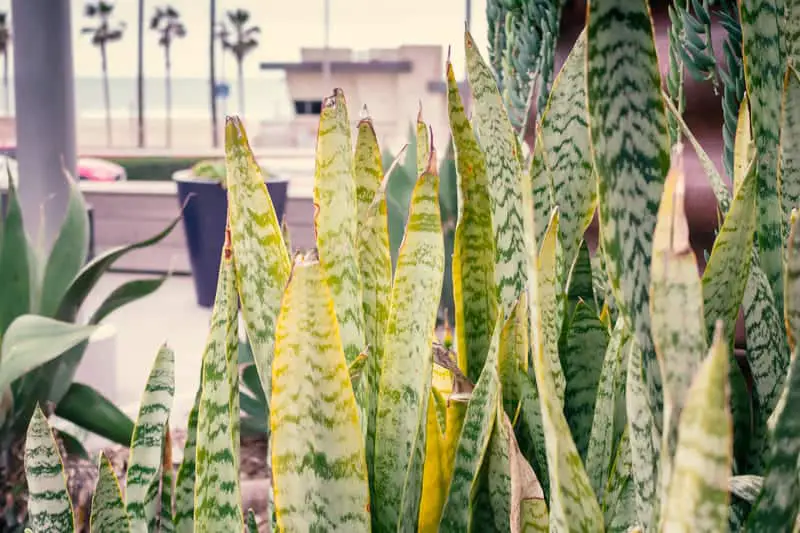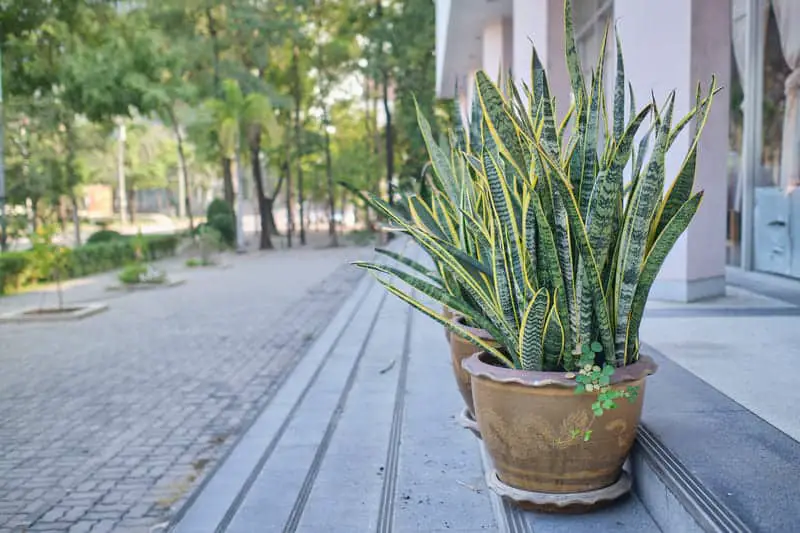Snake Plant or Dracaena trifasciata (also referred to as Sansevieria trifasciata) is an indoor gardeners’ favorite because of how they can be a decorative addition to your living space.
In addition, NASA declared it as an efficient air-purifying plant. It can eliminate toxins in the air, such as benzene, formaldehyde, xylene, and toluene.
You can water your snake plant every 2 to 3 days, especially during the summer days when they consume more water. However, if they are indoors and receiving sufficient light, spread out the watering schedule every 2-4 weeks.
The key to watering your snake plant is to water just the soil and avoid letting water touch the leaves. Deep-water them until the water drips out of your pot’s drainage holes.
Snake plants are well-known to gardeners because they need minimum care and thrive with neglect. Still, improper watering practices are the main reasons why they can die due to rotting.
Also check: Snake Plant Leaves Turning Yellow
Read more to find out how you can avoid this by following the right watering frequency and how you can revive your snake plant if this happens.
How often should you water a snake plant?
As we all know, the watering schedule will also depend on many different factors such as weather conditions, temperature, humidity, plant, and pot size.
During the winter, the temperatures will be cooler, and the plant’s sun exposure is reduced, which means that the soil will remain moist for a more extended period. This is why we only water this plant once a month. You must do this to prevent the soil from thoroughly drying out.
You can water your snake plant sparingly. Furthermore, watering it once a month is suitable since they don’t use as much water as they do during the summer months. But, of course, it is also dependent on how freezing the temperature is.
During spring, the plant will start its growing season too. You can increase the watering schedule to 1-2 weeks while allowing the topsoil to completely dry out between water schedules.
Overwatering your snake plant should be avoided because it is detrimental to its health. Make sure that your snake plant doesn’t sit in water for too long, as this could cause the plant to be mushy and start to rot over time.
As they say, the snake plant is hardy, and its death is always caused by overwatering. I should know because I killed my fair share of them due to improper water frequency.\
Also check: Can Snake Plants Live Outside?
It is still and always the best practice to check the top two inches of the soil before watering them. The soil must be dry and crumbly.
How much water do snake plants need?
This depends on the plant size, how big your pot is, and the weather conditions.
Typically, a larger plant needs more water. Also, if you reside in a place with dry heat, you may need to water them more than those who live in colder climates.
The rule of thumb is to water the plant thoroughly until the top 2 inches of the soil is completely soaked. Water the soil evenly. Don’t focus near the roots. Instead, I would advise you to the water near the inside edges of the pot. Doing this protects the base and leaves from getting water which could lead to rotting.
Let the water pass through the pot’s drainage holes, then give it another round of water. Let all the excess water drain out for the next 20 minutes. Then, before the following watering schedule, wait for the soil to completely dry out.
In a nutshell, water your snake plant infrequently but thoroughly. Let’s go over the other frequently asked questions about snake plants watering needs.
How do you know when your snake plant needs water?
When your snake plant needs water, the best way to tell it is to stick your index finger in the soil. It is time to water them when the soil is dry and crumbly.Another indication that it needs water is the brown spots on the tips and edges of the leaves.
Their fleshy leaves could start to dry out a little and may appear wrinkly dry.
Another thing to watch out for is when the tips of their leaves turn brownish-yellow, your snake plant is telling you to give it water.
All of these can be addressed by giving it adequate watering. Then, you may proceed to your usual watering schedule.
How often should you water a small snake plant?
Smaller snake plants need less water. For example, a 4-inch snake plant only needs to be watered every 2 weeks. This may seem less than what you are used to, but it should only be watered when the soil is without moisture.
Follow the same watering tips mentioned above. Water along the inside edges of the pot so the water does not build up near the plant’s base and leaves. Let the soil totally dry out between watering.
How long can snake plants go without water?
Snake plants are famous because they are low maintenance, resilient, and can withstand neglect. They originate from Africa and South Asia, so they have inherent tolerance to arid weather.They store water in their plump leaves, and their thick leaf cuticles reduce water loss.
Because of this, they have unique photosynthesis and can generate energy to make their food without using water. These may be the reasons why they thrive in meager water demand.
They can go without water for a few months, especially during winter. Yes, that is right. You may be inflicting more damage to them by overwatering them than leaving them alone. Trust me because I have been there and done that.
So put that sprinkler down and ease up on the watering. We should be on the dry and safer side. Check the soil first to know if it is time to water before you fetch your watering can.
What does an overwatered snake plant look like?
These plants can store up water in their leaves, roots, and rhizomes, making them prone to overwatering. This is why you don’t want to overwater your snake plant because it is more difficult to revive them when they’ve been given too much water.
As cliché as it sounds, too much of a good thing can be bad for your plant. This is absolutely true for Sansevieria babies.
The most obvious sign of an overwatered plant is their leaves will start to droop. These plants are known for rigid foliage that point upwards.
When they begin to sag from any angle, you need to cut back on watering. The leaves turning yellow and mushy at the plant base indicate overwatering or that root rot may have started.
Here is a simple checklist on how you can save your overwatered snake plant:
- Let the top 2 inches of soil completely dry out.
- Remove the plant from its pot and scrutinize the roots. If the roots have not started rotting, place the plant back on the container. Allow it to recover for 2 weeks, then follow the proper watering schedule.
- Water at the inside edge of the pot. Keep the plant base and leaves dry. Let the pot drain freely before placing it back on the drainage dish. Again, check that the top 2 inches of the soil are dry before you water it again.
- Change the potting soil if it is too dense and doesn’t drain out quickly. This could be the cause of the root rot. You may use a ready-made potting mix for succulents.
- If all the leaves have drooped, the base has turned yellow, and the roots are rotting, it is difficult to save the plant at this stage. Instead, you can choose to cut the leaf’s good part and propagate to create new snake plants by sticking them on well-draining soil.
Should I mist my snake plant?
Snake plants should never be misted.
As we mentioned earlier, we must avoid watering their leaves because they turn mushy and can lead to rot. We don’t want this to happen to your snake plant.
This plant is a close relative of the succulent. It has fleshy leaves where they store water and that helps them withstand dry weather and environment. When their leaves start to collect dust, it is better to use a dry cloth to wipe them clean than spray water.
Snake plants are one of the most famous house plants because of how they brighten homes and offices. They are known as natural air purifiers too. They are a great addition to your collection that thrives on neglect and a proper watering regimen.
Always remember to check the soil before you fetch your sprinkler.
With these watering tips, your snake plant should thrive and live for years. Oh, and when you keep them healthy enough, your snake plant may reward you with beautifully scented blooms too.




